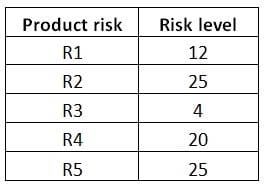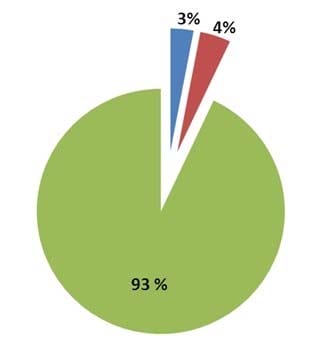Assume that you are the Test Manager for a small banking application development project.
You have decided to adopt a risk-based testing strategy and 5 product risks (R1, R2, R3, R4, and R5) have been identified during the quality risk analysis.
The following table shows the risk level associated to these product risks (higher numbers mean higher risk):

55 test cases have been designed and implemented to cover all these 5 product risks. The coverage is
described in a traceability matrix.
This is the test execution status table, after the after the first week of test execution:
About 56% of the planned test cases have been successfully executed.
Assume that no additional product risks have been identified during the first week of test execution.

Which of the following answers would you expect to best describe the residual risks associated with the identified product risks, at the end of the first week of test execution?
K3 2 credits
A. Since R3 is the only risk for which all test cases have passed, the risk has been reduced by 20%
B. The test execution status table indicates that the risk has been reduced by 56%
C. The residual risk level can't be determined, because it requires that all the test cases have been executed
D. The test execution table doesn't give an indication of the risk level of the open defects and the test cases that failed or are not run yet
In the next two months some new features will be constantly added to new releases of a project you are working on as Test Manager.
You have identified as one of the main project risks, that the requirements specification will still be incomplete when your team starts the test design and implementation phase.
Some requirements will most likely be completed too late to allow a proper test preparation.
You and your test team have already worked on several similar past projects in the same organization.
Which one of the following options would you expect to be the most effective at mitigating this risk?
K4 3 credits
A. Don't prepare any test and just run the regression test suite to check that the new features don't introduce regression
B. Make reasonable assumptions about the missing details and design lightweight tests that can be easily updated during test execution
C. Don't design any test until the test execution starts, then communicate that test execution is blocked due to incomplete requirements
D. Even if there are only few details missing, escalate the risk to the project manager without preparing any tests
You are estimating the effort for the integration testing activities of a new project. Consider the following factors, which can affect that estimation:
I. Availability of re-usable test systems and documentation from previous, similar projects
II. Unexpected timing of components arrival
III. Stability of the integration test team (no turnover)
IV.
Many and geographically distributed sub-teams Which of the following statements is true? K2 1 credit
A.
I. and II. can negatively affect the estimation III. and IV. usually favor the accuracy of the estimation effort
B.
II. and III. can negatively affect the estimation
C.
and IV. usually favor the accuracy of the estimation effort
D.
II. and IV. can negatively affect the estimation
E.
and III. usually favor the accuracy of the estimation effort
F.
III. and IV. can negatively affect the estimation
G.
and II. usually favor the accuracy of the estimation effort
Which of the following statements describing how identified product quality risks should be mitigated and managed, is true?
K2 1 credit A. The extent of re-testing and regression testing activities should be based on the risk level
B. The identification of new risks, the re-assessment of the level of existing risks and the evaluation of the effectiveness of risk mitigation activities should only occur at the very beginning of a project
C. Risk mitigation of product quality risks can be effective only after starting test execution
D. The priority of the development and execution of tests should not be based on the risk level but only on the likelihood
You are the Test Manager of a new project that will have three formal levels of testinG. unit, integration and system testing. The testing strategy you decide to adopt a blend of risk-based testing and reactive testing strategies.
Which of the following answers describes the most consistent example of implementation of this test strategy during the execution of the system tests?
K2 1 credit
A. Your test team executes exploratory tests following a session-based test management approach throughout the system test phase
B. Your test team executes system tests under the guidance of a sample of users throughout the system test phase
C. Your test team executes scripted tests designed and implemented before the execution of the system test phase, to cover the identified product risks. It also performs exploratory testing sessions throughout the system test phase
D. Your test team autonomously performs some exploratory testing sessions and, at the very end of the system testing phase, it also executes more system tests under the guidance of a sample of users
Consider the following list of statements about audits and management reviews:
I. Audits are usually more effective than management reviews at finding defects
II. Audits and management reviews have the same main goals, the only difference is related to the roles and level of formality
III. A typical outcome of an audit includes observations and recommendations, corrective actions and a pass/fail assessment
IV. An audit is not the appropriate mechanism to use at the code review in order to detect defects prior to dynamic testing
Which of the following statements is true?
K2 1 credit
A. I. and III. are true; II. and IV. are false;
B. II. and III are true; I. and IV. are false;
C. III. and IV. are true; I and II are false;
D. I, III and IV are true; II. is false;
Which of the following statements about the STEP test process improvement model is true? K2 1 credit
A. In the STEP model, tests validate the requirements and use cases when they are developed
B. The STEP model stresses defect detection and demonstration of capability, whereas the defect prevention is a secondary potential goal of testing
C. The STEP model assures that the system requirements specification and the test design specification processes don't overlap
D. In the STEP model, testware design occurs after coding
A chart showing the trend in the lag time from defect reporting to resolution during system testing is also available. The chart shows that the daily closure period is consistently and significantly above the rolling closure period for a long period of the system testing phase.
Almost all defects found during system testing have been related to the system as a whole, not related to single units or integrations issues. Almost all quality risks have been addressed during the unit and integration testing phase and no residual quality risks were present in the integrated system. This has been confirmed by exploratory testing sessions performed during system testing, targeted at finding defects in these quality risk areas.
Based on the given information only, which one of the following areas would you expect to be considered more in the retrospective meeting in order to be improved?
K3 3 credits
A. The requirements review
B. The defect management process
C. The quality risk analysis process
D. The system design and architecture design reviews
After the presentation, you are asked to explain the chart. Assume you have applied a full risk-based testing strategy.

Which of the following answers would you expect to best describe the pie chart?
K4 3 credits
A. All the risk items have been covered with tests. No more risk items remain to test
B. According to the full risk-based testing strategy applied, it is very likely that the highest- risk items, tests and bugs remain in the blue and red areas. Therefore, it is very risky to release the application
C. Only the lowest-risk items, tests and bugs should remain in the blue and red areas. Therefore the application can be released at any time subject to management of the items identified in those areas
D. 97 percent of the risk items has been tested. No open bugs or test failures remain. Only 3 percent of risk items remains to be covered by the remaining test
Assume you are a Test Manager involved in system testing of a CRM application for a Pay- TV company. Currently the application is able to support a proper number of users assuring the required responsiveness. Since the business is expected to grow, you have been asked to evaluate the ability of the application to grow to support more users while maintaining the same responsiveness.
Which of the following tools would you expect to be the most useful at performing this evaluation?
K2 1 credit
A. Coverage tools
B. Test management tools
C. Static analysis tools
D. Performance tools